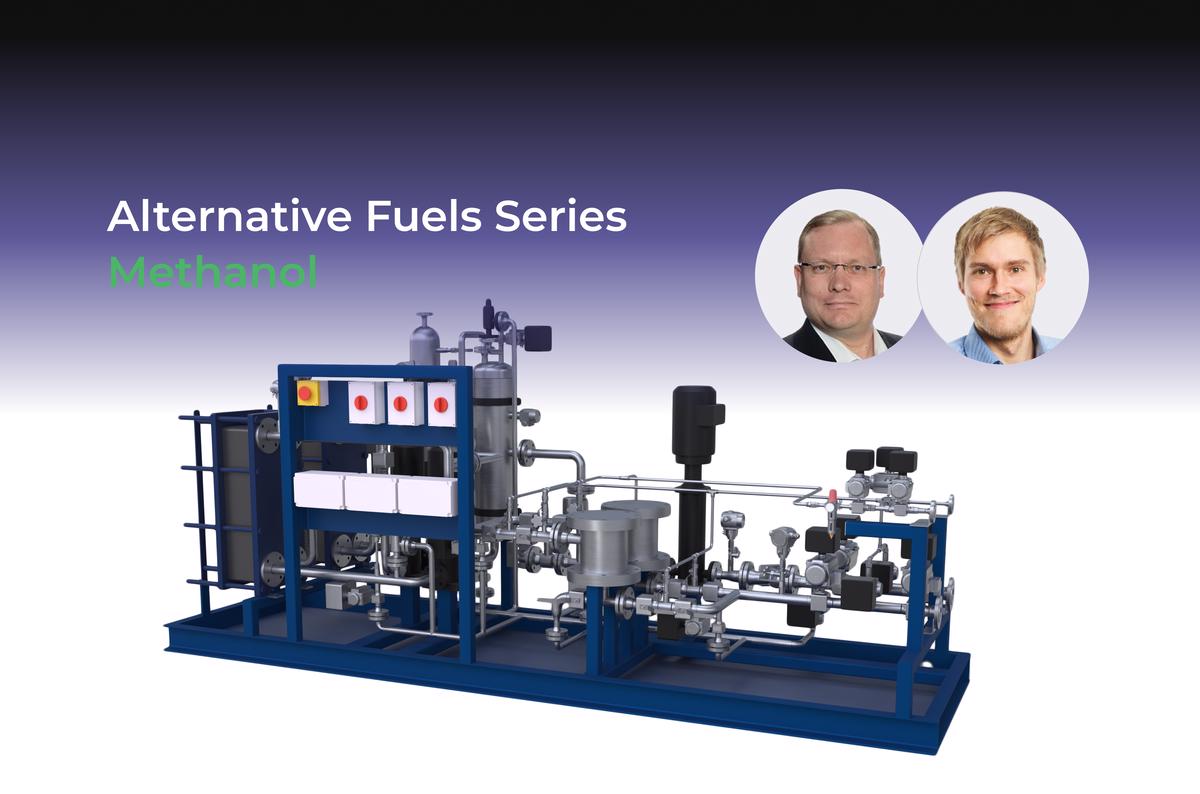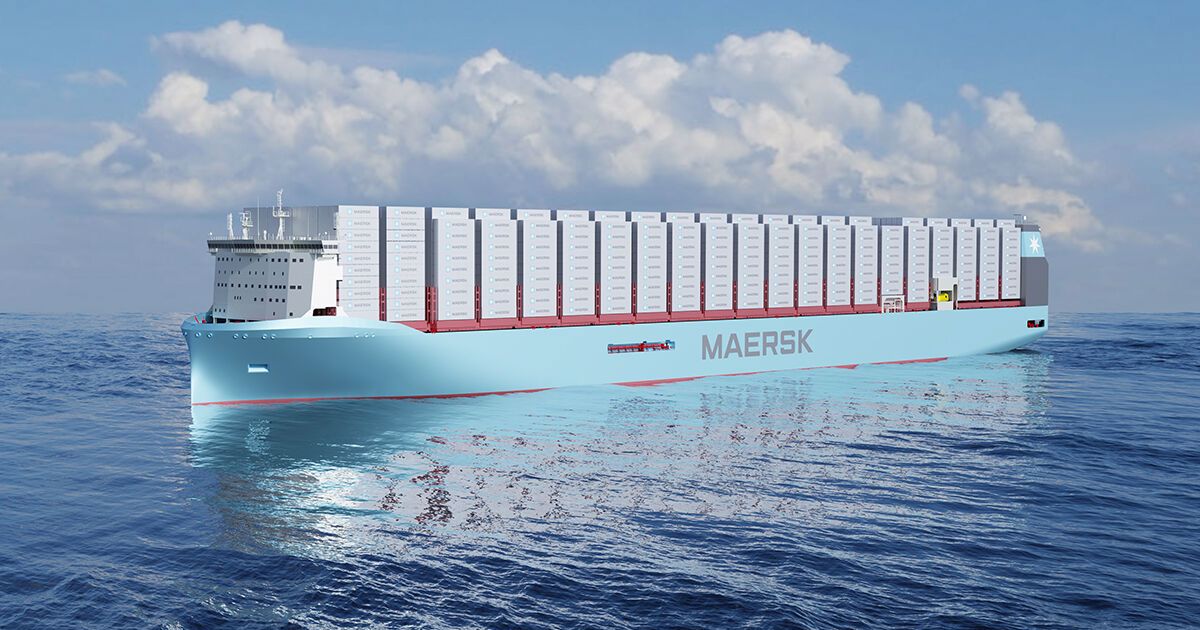Alternative Fuels Part 3: Methanol's head start
Finnish company Auramarine has recently developed a fuel supply system for methanol engines. ENGINE has spoken to Auramarine’s John Bergman and Valtteri Vainio to find out how methanol can be led smoothly from onboard fuel tanks to engines and boilers.
 PHOTO: Auramarine's methanol fuel supply system, with Auramarine chief executive John Bergman (left) and product manager Valtteri Vainio (right).
PHOTO: Auramarine's methanol fuel supply system, with Auramarine chief executive John Bergman (left) and product manager Valtteri Vainio (right).
“Methanol is among the most accessible clean fuel alternative, with more than one hundred ports worldwide already supplying the fuel. It also reduces greenhouse gas (GHG) emissions and other non-carbon emissions like sulphur oxides and nitrous oxides compared to diesel oil,” says Auramarine’s chief executive John Bergman.
Addressing why they chose to focus on methanol first and then ammonia, he adds, “methanol is a minute ahead of ammonia, since there is already an engine available, and so we are among the first movers in the maritime industry by developing a fuel supply unit for the future fuel.”
Safe passage from fuel tanks to engines
Auramarine’s methanol fuel supply system supplies methanol from the service tank to the main fuel valve in the engine. Service tanks onboard ships are used to store and supply treated fuel to main and auxiliary engines and boilers. In bringing the methanol from the service tanks, fuel supply systems will regulate its flow, pressure and temperature.
Fuel supply systems are equipped with a so-called nitrogen purging system, to clean the piping for safety reasons, says Auramarine product manager Valtteri Vainio. As a low flash point fuel, methanol becomes highly flammable when heated beyond 10°C.
Methanol is also fully soluble in water, so a mixture of water and methanol will still cause a fire. As a precaution, nitrogen is used to clean the pipes that carry methanol fuel. An injection of nitrogen is used to flush out any remaining fuel in the fuel piping, a process known as nitrogen purging. Since nitrogen is an inert gas, it helps stabilise the pipeline environment, reducing risks of fire.
Low on energy but less space needed
One of the major technological advantages for methanol, according to Auramarine, is that “existing fuel oil tanks can be used for storage with little modification as methanol can be stored at ambient pressure and temperature. Although it has lower volumetric energy density than liquefied natural gas (LNG), the tank arrangements for methanol can still fit in a smaller space as no cryogenic or high-pressure infrastructure is required.”
“The fuel supply units are suitable for both two-stroke and four-stroke engines and can be adapted to suit the conversion of existing engines to dual-fuel methanol operation. A pilot fuel system is required for methanol operations in dual-fuel engines, and Auramarine has extended its experience of pilot fuel systems for LNG to methanol supply. The engine has separate pilot injectors where it supplies a little pilot fuel to ignite the methanol fuel,” says Vainio.
The company has already developed the fuel supply unit for methanol and expects to make the first delivery of its fuel supply system to a customer early next year. “There is a newbuild project already lined up, but we have also received some retrofit inquiries,” he adds.
Age-old chemical
WIth methanol uptake set to rise, many in the industry have raised concerns about drawbacks around its usage, such as toxicity and corrosiveness. However, Bergman argues, these are not barriers to fuelling ships engines with methanol as it has been traded and transported as chemical cargo for decades.
“Auramarine uses stainless steel to build the fuel systems to prevent corrosion and uses a leak-detection system that alerts crew to any leakages from the unit,” Vainio says.
While this can provide a sigh of relief, methanol, as it is currently produced, is not zero-carbon. Most methanol is today produced through steam-reforming of natural gas globally, and of coal in China. Its production and consumption result in 165 million mt/year of carbon dioxode emissions across sectors, according to the International Methanol Producers and Consumers Association.
 CHART: Main routes to producing methanol. International Renewable Energy Agency (IRENA)
CHART: Main routes to producing methanol. International Renewable Energy Agency (IRENA)
Fossil vs renewable methanol
Switching to renewable methanol would dramatically reduce these emissions and help the marine sector achieve upcoming decarbonisation targets. While fossil and renewable methanol molecules are identical, they differ in their production process and emission profiles. There are two types of renewable methanol: bio-methanol and e-methanol.
Bio-methanol is produced from sustainable biomass, which can be derived from agricultural waste, plant waste, food waste or manure. It requires little to no fossil fuel, but carbon dioxide and carbon monoxide is naturally contained in these waste streams and they can ideally be considered carbon-neutral.
E-methanol, or synthetic methanol, is produced from carbon dioxide (CO2) captured from renewable sources like bioenergy with carbon capture and storage (BECCS) or direct air capture (DAC). This is in turn reacted with hydrogen using a catalyst.
Both types of methanol can be carbon-neutral, and have almost zero emissions of nitrous and sulphur oxides and particulates.
Limited renewable supply
So, what could stop more shipowners from chosing green methanol to reduce emissions when regulations tighten? "For methanol, the issue is related to fuel logistics and fuel supply issues as there is a fairly limited amount of green methanol available," Bergman notes, and numbers support his assertion.
Around 98 million mt/year of fossil methanol is produced globally, compared to less than 0.2 million mt/year of renewable methanol, according to the International Renewable Energy Agency (IRENA). Almost all of this renewable methanol is bio-methanol. IRENA forecasts total methanol production to multiply manifold to meet rising demand over the coming decades. By 2050, it projects the world can produce 500 million mt/year of fossil methanol, 250 million mt/year of e-methanol and 135 million mt/year of bio-methanol.
Economies of scale and costs
The slow expansion of renewable methanol production to date can be partly attributed to its higher production costs when compared to natural gas or coal-based methanol. IRENA’s back-of-envelope calculation has projected the current production cost of e-methanol in the range of $800-1,600/mt when CO2 is sourced from BECCS, and $1,200-2,400/mt and when CO2 is obtained by DAC. The cost of producing fossil fuel-based methanol is currently around $100-250/mt. But IRENA also expects renewable methanol production costs to come off sharply towards 2050, as renewable energy production capacity increases.
Demand drivers
On the bunker demand side, Danish shipping major A.P. Moller - Maersk has taken initiative to stimulate global methanol production.
Maersk has partnered with eight green methanol suppliers to source over 1 million mt of green methanol by 2025 for its fleet of 19 methanol vessels on order for delivery. It has also struck agreements with the Spanish government to produce up to 2 million mt/year of green methanol, and with the Jordanian government to explore production of green methanol in Jordan's Aqaba region.
 PHOTO: Model of Maersk's 17,000 TEU methanol-powered container ship. A.P. Moller-Maersk
PHOTO: Model of Maersk's 17,000 TEU methanol-powered container ship. A.P. Moller-Maersk
Auramarine chief executive Bergman says the shipping industry is "waiting for the right fuel infrastructure for methanol bunkering, and the sooner we start building these bunkering and fuel supply systems, the faster we will be on track."
"We also know there is no single solution for decarbonisation. There will be a multitude of solutions, including methanol, ammonia, and different sorts of biodiesels. There’s no ‘silver bullet’ or solution that will suit everyone, but instead there is a need for tailor-made packages for each vessel."
By Konica Bhatt
Please get in touch with comments or additional info to news@engine.online





